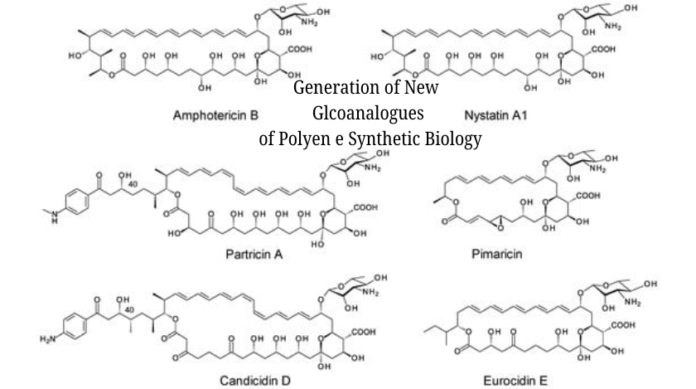Synthetic biology is shaking up everything we know about pharmaceuticals, especially when it comes to natural products like polyenes. One exciting area? The generation of glycoanalogues modified forms of polyenes enhanced with sugar moieties that change how they behave in the body. It’s like giving a natural molecule a smart upgrade.
So how are these sugar-studded polyenes made? That’s where the magic of synthetic biology comes in.
Polyenes A Brief Overview
What Are Polyenes?
Polyenes are a group of organic compounds known for having multiple conjugated double bonds. They’re commonly found in natural antifungal agents like Amphotericin B and Nystatin.
Clinical Applications Especially in Antifungals
These compounds have been the gold standard for treating fungal infections for decades. Their ability to bind to ergosterol, a key component of fungal cell membranes, makes them incredibly effective but not without drawbacks.
Limitations of Traditional Polyene Drugs
Unfortunately, polyenes come with serious side effects, especially kidney toxicity. They’re also poorly soluble in water, making delivery tough. This is where glycoengineering offers a potential solution.
Glycoanalogues What and Why?
Definition of Glycoanalogues
Glycoanalogues are molecules that resemble their parent compound but are modified to carry different sugar groups (glycans). These sugars can change how the drug behaves in a biological system from solubility to how it’s absorbed or cleared.
Advantages Over Traditional Molecules
Adding or altering sugar components can:
-
Improve water solubility
-
Reduce toxicity
-
Increase bioavailability
-
Allow for targeted delivery
Enhancing Efficacy and Solubility
Just like putting better tires on a sports car, glycoanalogues can help polyenes work smoother and faster, especially in complex environments like the human body.
The Role of Glycosylation in Polyenes
Natural Glycosylation Pathways
Nature already uses glycosylation to alter how molecules work. In polyenes, naturally occurring sugars modulate antifungal activity and pharmacokinetics.
Influence on Pharmacokinetics and Bioactivity
The right glycan can change:
-
Absorption rate
-
Metabolic breakdown
-
Tissue distribution
Impact on Host Toxicity
Strategic glycosylation can help prevent the polyene from binding to cholesterol in human cells, which is a major cause of toxicity.
Synthetic Biology Redesigning Nature
What is Synthetic Biology?
It’s the art of designing and constructing new biological systems using DNA. Think of it like using Lego blocks to build a custom organism.
Tools of the Trade CRISPR, Gene Clusters, Pathway Engineering
With synthetic biology, scientists can:
-
Insert or delete genes
-
Modify biosynthetic pathways
-
Create novel metabolic networks
Why Use Synthetic Biology for Polyenes?
Traditional chemical modifications of polyenes are difficult and inefficient. Synthetic biology allows us to reprogram microbes to make better versions directly.
Engineering Glycosylation Pathways
Strategies for Introducing New Sugar Moieties
One way to engineer glycoanalogues is by inserting glycosyltransferase genes into the producing organism. These enzymes attach different sugars to the polyene scaffold.
Combinatorial Biosynthesis of Glycoanalogues
This involves mixing and matching biosynthetic genes from different organisms to produce a library of polyene variants like crafting custom cocktails with different flavors.
Host Organisms From Streptomyces to E. coli
Streptomyces is a popular choice for producing polyenes. But synthetic biology also allows us to move pathways into more tractable hosts like E. coli or Saccharomyces cerevisiae.
Case Studies and Recent Breakthroughs
Amphotericin B Glycoengineering
Scientists have created glyco-modified Amphotericin B analogues with reduced nephrotoxicity while maintaining potent antifungal activity. A major win in drug design.
Nystatin Derivatives with Modified Glycans
Using synthetic pathways, researchers have produced Nystatin glycoanalogues that are not only more water-soluble but also more stable and easier to formulate.
Novel Polyene Analogues with Reduced Toxicity
There’s ongoing work to develop polyene analogues that avoid binding to cholesterol altogether potentially eliminating the main cause of side effects.
Challenges in Generating Glycoanalogues
Metabolic Burden and Pathway Crosstalk
Adding new biosynthetic pathways can stress the host cell and reduce yields. Fine-tuning is critical to balance growth and production.
Stability of Engineered Products
Engineered polyenes can sometimes be chemically unstable or degrade too quickly. Solutions involve optimizing fermentation conditions and post-synthesis processing.
Regulatory Hurdles for Modified Natural Products
Even if they’re safer and more effective, glycoanalogues face stringent regulatory reviews due to their engineered nature.
Applications and Future Prospects
Developing Safer Antifungals
This is the immediate and most impactful goal. Glycoanalogues offer hope for effective yet safe treatments for life-threatening fungal infections.
Expanding into Antivirals and Immunomodulators
Some modified polyenes show activity beyond antifungals, including effects on immune pathways and even viral envelopes.
Integration with AI and Machine Learning for Design
Using AI, researchers can predict the most promising sugar modifications before lab work even begins speeding up development cycles.
Conclusion
Synthetic biology is revolutionizing how we create and optimize natural drugs. The generation of glycoanalogues of polyenes is one of the most promising developments in this space marrying the potency of nature with the precision of engineering.
We’re entering a future where we won’t just accept nature’s gifts we’ll enhance them.
FAQs
1. What are glycoanalogues in the context of polyenes?
They are chemically or biologically modified polyenes that include altered sugar groups to improve drug properties like solubility, efficacy, and safety.
2. How does glycosylation affect drug activity?
It can change how the drug is absorbed, how long it stays active in the body, and how it interacts with target or off-target cells.
3. Why is synthetic biology important for developing new antibiotics?
It allows for custom design and mass production of optimized compounds that are otherwise difficult to synthesize chemically.
4. Can synthetic biology reduce side effects of polyene drugs?
Yes. By changing how the molecule interacts with human cells (like avoiding cholesterol binding), side effects like nephrotoxicity can be greatly reduced.
5. What future applications can we expect from glycoengineered drugs?
Expect new treatments for fungal infections, antiviral therapies, improved vaccines, and even anticancer agents with higher selectivity.


